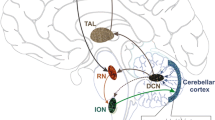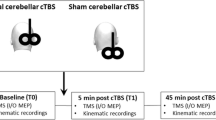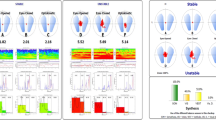Abstract
The pathogenesis of essential tremor (ET) is still under debate. Several lines of evidence indicate that ET is associated with cerebellar dysfunction. The aim of the present study was to find corroborating evidence for this claim by investigating balance and speech impairments in patients with ET. In addition, the effect of deep brain stimulation (DBS) on balance and speech function was studied. A group of 25 ET patients including 18 with postural and/or simple kinetic tremor (ETpt) and seven ET patients with additional clinical signs of cerebellar dysfunction (ETc) was compared to 25 healthy controls. In addition, 12 ET patients with thalamic DBS participated in the study. Balance control was assessed during gait and stance including tandem gait performed on a treadmill as well as static and dynamic posturography. Motor speech control was analyzed through syllable repetition tasks. Signs of balance impairment were found in early stages and advanced stages of ET. During locomotion, ET patients exhibited an increased number of missteps and shortened stride length with tandem gait. ETc patients and, to a lesser extent, ETpt patients had increased postural instability in dynamic posturography conditions that are sensitive to vestibular or vestibulocerebellar dysfunction. ETc but not ETpt patients exhibited significantly increased syllable durations. DBS had no discernable effect on speech performance or balance control. We conclude that the deficits in balance as well as the subclinical signs of dysarthria in a subset of patients confirm and extend previous findings that ET is associated with an impairment of the cerebellum.



Similar content being viewed by others
References
Deuschl G, Bain P, Brin M (1998) Consensus statement of the Movement Disorder Society on Tremor. Ad Hoc Scientific Committee. Mov Disord 13:2–23
Deuschl G, Elble RJ (2000) The pathophysiology of essential tremor. Neurology 54:S14–S20
Wilms H, Sievers J, Deuschl G (1999) Animal models of tremor. Mov Disord 14:557–571
Dupuis MJ, Delwaide PJ, Boucquey D, Gonsette RE (1989) Homolateral disappearance of essential tremor after cerebellar stroke. Mov Disord 4:183–187
Rajput AH, Maxood K, Rajput A (2008) Classic essential tremor changes following cerebellar hemorrhage. Neurology 71:1739–1740
Colebatch JG, Findley LJ, Frackowiak RS, Marsden CD, Brooks DJ (1990) Preliminary report: activation of the cerebellum in essential tremor. Lancet 336:1028–1030
Jenkins IH, Bain PG, Colebatch JG et al (1993) A positron emission tomography study of essential tremor: evidence for overactivity of cerebellar connections. Ann Neurol 34:82–90
Boecker H, Wills AJ, Ceballos-Baumann A et al (1996) The effect of ethanol on alcohol-responsive essential tremor: a positron emission tomography study. Ann Neurol 39:650–658
Louis ED, Faust PL, Vonsattel JP et al (2007) Neuropathological changes in essential tremor: 33 cases compared with 21 controls. Brain 130:3297–3307
Daniels C, Peller M, Wolff S et al (2006) Voxel-based morphometry shows no decreases in cerebellar gray matter volume in essential tremor. Neurology 67:1452–1456
Deuschl G, Wenzelburger R, Loffler K, Raethjen J, Stolze H (2000) Essential tremor and cerebellar dysfunction clinical and kinematic analysis of intention tremor. Brain 123:1568–1580
Köster B, Deuschl G, Lauk M, Timmer J, Guschlbauer B, Lücking CH (2002) Essential tremor and cerebellar dysfunction: abnormal ballistic movements. J Neurol Neurosurg Psychiatry 73:400–405
Helmchen C, Hagenow A, Miesner J et al (2003) Eye movement abnormalities in essential tremor may indicate cerebellar dysfunction. Brain 126:1319–1332
Kronenbuerger M, Gerwig M, Brol B, Block F, Timmann D (2007) Eyeblink conditioning is impaired in subjects with essential tremor. Brain 130:1538–1551
Thach WT, Bastian AJ (2004) Role of the cerebellum in the control and adaptation of gait in health and disease. Prog Brain Res 143:353–366
Bove M, Marinelli L, Avanzino L, Marchese R, Abbruzzese G (2006) Posturographic analysis of balance control in patients with essential tremor. Mov Disord 21:192–198
Baloh RW, Jacobson KM, Beykirch K, Honrubia V (1998) Static and dynamic posturography in patients with vestibular and cerebellar lesions. Arch Neurol 55:649–654
Konczak J, Schoch B, Dimitrova A, Gizewski E, Timmann D (2005) Functional recovery of children and adolescents after cerebellar tumor resection. Brain 128:1428–1441
Singer C, Sanchez-Ramos J, Weiner WJ (1994) Gait abnormality in essential tremor. Mov Disord 9:193–196
Hubble JP, Busenbark KL, Pahwa R, Lyons K, Koller WC (1997) Clinical expression of essential tremor: effects of gender and age. Mov Disord 12:969–972
Stolze H, Petersen G, Raethjen J, Wenzelburger R, Deuschl G (2001) The gait disorder of advanced essential tremor. Brain 124:2278–2286
Merk M, Ziegler M (1999) A PC-based system for routine acoustic speech analysis of neurogenic speech disorders. In: Maasen B, Groenen P (eds) Pathologies of speech and language. Advances in clinical phonetics and linguistics. Whuss, London, pp 315–321
Ziegler W (2002) Task-related factors in oral motor control: speech and oral diadochokinesis in dysarthria and apraxia of speech. Brain Lang 80:556–575
Ackermann H, Mathiak K, Riecker A (2007) The contribution of the cerebellum to speech production and speech perception: clinical and functional imaging data. Cerebellum 6:202–213
Benabid AL, Pollak P, Gao D et al (1996) Chronic electrical stimulation of the ventralis intermedius nucleus of the thalamus as a treatment of movement disorders. J Neurosurg 84:203–214
Limousin-Dowsey P (2004) Thalamic stimulation in essential tremor. Lancet Neurol 3:80
Pahwa R, Lyons KE, Wilkinson SB et al (2006) Long-term evaluation of deep brain stimulation of the thalamus. J Neurosurg 104:506–512
Earhart GM, Clark BR, Tabbal SD, Perlmutter JS (2009) Gait and balance in essential tremor: variable effects of bilateral thalamic stimulation. Mov Disord 24(3):386–391
Ondo WG, Almaguer M, Cohen H (2006) Computerized posturography balance assessment of patients with bilateral ventralis intermedius nuclei deep brain stimulation. Mov Disord 21:2243–2247
Macchi G, Jones EG (1997) Toward an agreement on terminology of nuclear and subnuclear divisions of the motor thalamus. J Neurosurg 86:670–685
Fahn S, Tolosa E, Marin C (1988) Clinical rating scale for tremor. In: Jankovic J, Tolosa E (eds) Parkinson´s disease and movement disorders. Urban and Schwarzenberg, Munich, pp 271–280
Trouillas P, Takayanagi T, Hallett M et al (1997) International Cooperative Ataxia Rating Scale for pharmacological assessment of the cerebellar syndrome. The Ataxia Neuropharmacology Committee of the World Federation of Neurology. J Neurol Sci 145:205–211
Krack P, Dostrovsky J, Ilinsky I et al (2002) Surgery of the motor thalamus: problems with the present nomenclatures. Mov Disord 17:S2–S8
Cartford MC, Allgeier CA, Bickford PC (2002) The effects of beta-noradrenergic receptor blockade on acquisition of eyeblink conditioning in 3-month-old F344 rats. Neurobiol Learn Mem 78:246–257
Huffman JC, Stern TA (2007) Neuropsychiatric consequences of cardiovascular medications. Dialogues Clin Neurosci 9:29–45
Ondo WG, Sutton L, Dat Vuong K, Lai D, Jankovic J (2003) Hearing impairment in essential tremor. Neurology 61:1093–1097
Louis ED, Borden S, Moskowitz CB (2005) Essential tremor centralized brain repository: diagnostic validity and clinical characteristics of a highly selected group of essential tremor cases. Mov Disord 20:1361–1365
Benito-León J, Louis ED, Bermejo-Pareja F, Neurological Disorders in Central Spain (NEDICES) Study Group (2007) Reported hearing impairment in essential tremor: a population-based case-control study. Neuroepidemiology 29:213–217
Bortz J (2005) Statistik: Für Human- und Sozialwissenschaftler. Springer, Berlin
Palliyath S, Hallett M, Thomas SL, Lebiedowska MK (1998) Gait in patients with cerebellar ataxia. Mov Disord 13:958–964
Ebersbach G, Sojer M, Valldeoriola F et al (1999) Comparative analysis of gait in Parkinson's disease, cerebellar ataxia and subcortical arteriosclerotic encephalopathy. Brain 122:1349–1355
Stolze H, Klebe S, Petersen G et al (2002) Typical features of cerebellar ataxic gait. J Neurol Neurosurg Psychiatry 73:310–312
Morton SM, Bastian AJ (2003) Relative contributions of balance and voluntary leg-coordination deficits to cerebellar gait ataxia. J Neurophysiol 89:1844–1856
Diener HC, Dichgans J (1988) [Applications and uses of static and dynamic measurement of posture (posturography)]. Fortschr Neurol Psychiatr 56:249–258
Halmagyi GM, Colebatch JG, Curthoys IS (1994) New tests of vestibular function. Baillieres Clin Neurol 3:485–500
Kemp DT (2002) Otoacoustic emissions, their origin in cochlear function, and use. Br Med Bull 63:223–241
Ackermann H, Hertrich I, Hehr T (1995) Oral diadochokinesis in neurological dysarthrias. Folia Phoniatr Logop 47:15–23
Kent RD, Netsell R, Abbs JH (1979) Acoustic characteristics of dysarthria associated with cerebellar disease. J Speech Hear Res 22:627–648
Kent RD, Weismer G, Kent JF, Vorperian HK, Duffy JR (1999) Acoustic studies of dysarthric speech: methods, progress, and potential. J Commun Disord 32:141–180
Ziegler W, Deger K, Brendel B, Aichert I (2001) The chaining of syllables in apraxia of speech. In: Maassen B, Hulstijn W, Kent RD, Peters HFM, van Leishout PHHM (eds) Speech motor control in normal and disordered speech. Nijmegen University Press, Nijmegen, pp 343–346
Gamboa J, Jimenez-Jimenez FJ, Nieto A et al (1998) Acoustic voice analysis in patients with essential tremor. J Voice 12:444–452
Putzke JD, Uitti RJ, Obwegeser AA, Wszolek ZK, Wharen RE (2005) Bilateral thalamic deep brain stimulation: midline tremor control. J Neurol Neurosurg Psychiatry 76:684–690
McIntyre CC, Savasta M, Kerkerian-Le Goff L, Vitek JL (2004) Uncovering the mechanism(s) of action of deep brain stimulation: activation, inhibition, or both. Clin Neurophysiol 115:1239–1248
Johnson MD, Miocinovic S, McIntyre CC, Vitek JL (2008) Mechanisms and targets of deep brain stimulation in movement disorders. Neurotherapeutics 5:294–308
Klebe S, Stolze H, Grensing K, Volkmann J, Wenzelburger R, Deuschl G (2005) Influence of alcohol on gait in patients with essential tremor. Neurology 65:96–101
Manto M, Laute MA (2008) A possible mechanism for the beneficial effect of ethanol in essential tremor. Eur J Neurol 15:697–705
Acknowledgment
The authors wish to thank Beate Brol for technical support. This study was supported by a research grant to M. K. from the Medical Faculty, University Hospital Aachen, RWTH Aachen, Germany.
Author information
Authors and Affiliations
Electronic Supplementary Material
Below is the link to the electronic supplementary material.
Rights and permissions
About this article
Cite this article
Kronenbuerger, M., Konczak, J., Ziegler, W. et al. Balance and Motor Speech Impairment in Essential Tremor. Cerebellum 8, 389–398 (2009). https://doi.org/10.1007/s12311-009-0111-y
Received:
Accepted:
Published:
Issue Date:
DOI: https://doi.org/10.1007/s12311-009-0111-y




